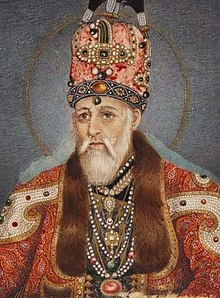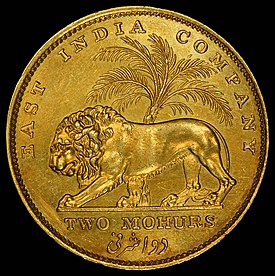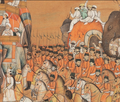Akbar II
This articleneeds additional citations forverification.(May 2017) |
| Akbar II | |||||||||||||
|---|---|---|---|---|---|---|---|---|---|---|---|---|---|
| King of Delhi Badshah Shahanshah-e-Hind | |||||||||||||
 Portrait of Akbar Shah II,c. 1827 | |||||||||||||
| Emperor of Hindustan | |||||||||||||
| Reign | 19 November 1806 – 28 September 1837 | ||||||||||||
| Coronation | 19 November 1806 | ||||||||||||
| Predecessor | Shah Alam II | ||||||||||||
| Successor | Bahadur Shah II | ||||||||||||
| Born | Mirza Akbar 22 April 1760 Mukundpur,Rewa State,Maratha Confederacy | ||||||||||||
| Died | 28 September 1837(aged 77) Delhi,Mughal Empire | ||||||||||||
| Burial | Moti Masjid,Delhi, India | ||||||||||||
| Spouse | Mumtaz Mahal[1] Anwar Mahal[2] Lal Bai[3] | ||||||||||||
| Issue | 14 sons including
Mirza Firuz Bakht 8 daughters | ||||||||||||
| |||||||||||||
| House | House of Babur | ||||||||||||
| Dynasty | Timurid dynasty | ||||||||||||
| Father | Shah Alam II | ||||||||||||
| Mother | Qudsia Begum | ||||||||||||
| Religion | Sunni Islam(Hanafi) | ||||||||||||
| Seal |  | ||||||||||||
| Mughal emperors | ||||||||||||||||||||||||||||||||||||||||||||||
|---|---|---|---|---|---|---|---|---|---|---|---|---|---|---|---|---|---|---|---|---|---|---|---|---|---|---|---|---|---|---|---|---|---|---|---|---|---|---|---|---|---|---|---|---|---|---|
|
||||||||||||||||||||||||||||||||||||||||||||||
Akbar II(Persian pronunciation:[ak.baɾ];22 April 1760 – 28 September 1837), also known asAkbar Shah II,was the nineteenthMughal emperorfrom 1806 to 1837. He was the second son ofShah Alam IIand the father ofBahadur Shah II,who would eventually succeed him and become the last Mughal emperor.
Akbar had little de facto power due to the increasing British influence in India through theEast India Company.He sentRam Mohan Royas an ambassador to Britain and gave him the title of Raja. During his regime, in 1835, the East India Company discontinued calling itself subject of the Mughal Emperor and issuing coins in his name. The Persian lines in the company's coins to this effect were deleted.
Akbar II was credited with starting theHindu–Muslim unityfestivalPhool Walon Ki Sair.[5][6]His grave lies next to thedargahof 13th-century Sufi saintQutbuddin Bakhtiar KakiatMehrauli.
Early life
[edit]
Prince Mirza Akbar was born on 22 April 1760 to EmperorShah Alam IIatMukundpur,Satna,while his father was in exile. On 2 May 1781, at theRed Fort,the prince was madeCrown princewith the title ofWali AhdBahadur,after the death of his elder brother. In 1782, he was appointed the viceroy of Delhi until 1799. When theRohillaleaderGhulam Qadircaptured Delhi in 1788, the young Prince Mirza Akbar was forced tonautchdance along with other Mughal princes. He witnessed how the members of the imperial Mughal family were humiliated, as well as starved. WhenShah Jahan IVfled, Mirza Akbar was titular Emperor with the title ofAkbar Shah II,and was to remain acting emperor even after the reinstatement of his fatherShah Alam II,till January 1789.
Reign
[edit]



Emperor Akbar II presided over an empire titularly large but in effect limited to theRed Fortin Delhi alone. The cultural life of Delhi as a whole flourished during his reign. However, his attitude towards East India Company officials, especiallyLord Hastings,to whom he refused to grant an audience on terms other than those of subject and sovereign, although honourable to him, increasingly frustrated the British, who regarded him as merely their pensioner. The British therefore reduced his titular authority to 'King of Delhi' in 1835 and the East India Company ceased to act as the mere lieutenants of the Mughal Empire as they did from 1803 to 1835. Simultaneously they replaced Persian text with English text on the company's coins, which no longer carried the emperor's name.
The British encouraged the Nawab ofOudhand theNizam of Hyderabadto take royal titles to further diminish the Emperor's status and influence. Out of deference, the Nizam did not, but theNawab of Awadhdid so.
He is also known to have bestowed the titleNawabupon theNawab of TonkandNawab of Jaora.
Akbar II appointed the Bengali reformer Ram Mohan Roy, to appeal against his treatment by the East India Company, conferring on him the title of Raja. Ram Mohan Roy then visited England, as the Mughal envoy to the Court of St. James. Ram Mohan Roy submitted a well-argued memorial on behalf of the Mughal ruler, but to no avail.
The grave of Akbar II lies within a marble enclosure adjoined to theMoti Masjidnear thedargahof the 13th century Sufi saint,Qutbuddin Bakhtiar KakiatMehrauli,Delhi. The Mughal emperorsBahadur Shah I,(Shah Alam I) andShah Alam IIare also buried here.[7]
-
Akbar II holding audience on the Peacock Throne.
-
Silver Rupee coin of Akbar II.
-
Akbar Shah II rides an elephant in a huge procession 1835
-
Akbar Shah II and his four sons
-
Durbar Procession of Mughal Emperor Akbar II, with British Resident Charles Metcalfe, by Udey Ram
-
Cavalry in Durbar Procession of Mughal Emperor Akbar II
-
Mounted standard-bearers in the procession of Akbar II
Descendants
[edit]
After the mutiny, cousins ofMirza Mughal,son ofBahadur Shah Zafar,son of Akbar II, escaped to neighbouring areas in fear of capture by the British. PrinceMirza Mughal,the heir apparent was himself captured and executed by the British nearDelhi gate.Many surviving princes settled in various provinces of India, but some settled inBurma,BengalandDeccansince a large number of imperial family members, along with EmperorBahadur Shah IIwere exiled to Rangoon inBurma.
See also
[edit]References
[edit]- ^Jatindra Kumar Majumdar, ed. (1939).Raja Rammohun Roy and the Last Moghuls: A Selection from Official Records, 1803–1859.Art Press. pp. xxxiii.ISBN9788170410645.
- ^Indian History Congress (1958).Proceedings, Volume 20.Indian History Congress. p. 316.
- ^Syed Mahdi Husain (2006).Bahadur Shah Zafar and the War of 1857 in Delhi.Aakar Books. p. 36.ISBN9788187879916.
- ^"GREAT ESCAPE OF MIRZA JAHAN KHUSRO SON OF AKBAR SANI – HAJI MUHAMMED ISHAQUE DESCENDANT OF GREAT MUGHALS".15 April 2020.
- ^Dec 8, TNN / (8 December 2012)."Akbar, Dara Shikoh had set examples of Hindu-Muslim unity | Varanasi News – Times of India".The Times of India.
{{cite news}}:CS1 maint: numeric names: authors list (link) - ^"Akbar and his religious policy"(PDF).
- ^Dadlani, Chanchal B. (2018).From stone to paper: architecture as history in the late Mughal Empire.New Haven [CT]. p. 63.ISBN978-0-300-23317-9.OCLC1024165136.
{{cite book}}:CS1 maint: location missing publisher (link)
Bibliography
[edit]- Whitehead, Richard Bertram(1929). "Akbar II as Pretender: A Study in Anarchy".Journal of the Royal Asiatic Society of Great Britain and Ireland.61(2): 259–272.doi:10.1017/S0035869X00082149.ISSN0035-869X.JSTOR25193883.S2CID163201364.
![]() Media related toAkbar IIat Wikimedia Commons
Media related toAkbar IIat Wikimedia Commons





